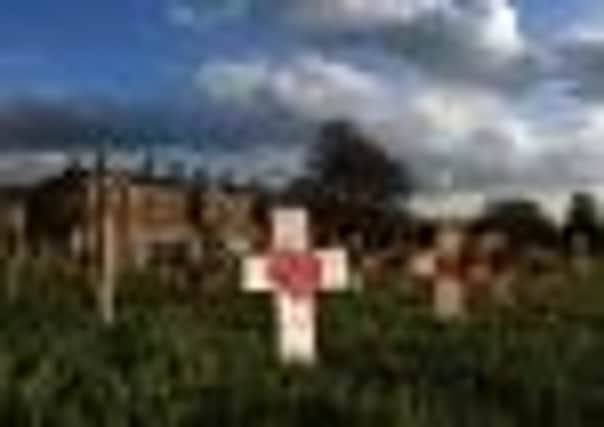Campus with lesson for young on horrors of war


British soldiers, together with other nationalities including Americans, Belgians and French, were transported from the front by boat and then brought to Leeds by train after being injured during the Great War.
Many were brought to the campus of the former City of Leeds Training College, now part of the campus of Leeds Metropolitan University, where they were treated.
Advertisement
Hide AdAdvertisement
Hide AdThis year’s field of remembrance on the acre at the Headingley Campus was launched yesterday, with a service of dedication outside the James Graham building.
During both conflicts the Headingley campus became a military hospital, where more than 200 troops from the First World War died from their injuries.
During the conflict the site was a major surgical hospital, treating more than 57,000 troops during the war years.
Throughout the Second World War the campus was still a military medical facility but focused on training field medics to be dispatched to all areas of conflict.
Casualties from Dunkirk were also brought to the campus.
Advertisement
Hide AdAdvertisement
Hide AdIan Crossland, a senior technician at the university, said during the First World War the hospital dealt with a lot of amputees, who, when they were well enough, had to travel to another location in Leeds to get false limbs fitted.
“It was a major surgical ward,” he said. “There were a lot of amputees, if your leg had been amputated you got two pence, one pence to get you into Leeds to get your leg fitted and then one pence to get back on the tram.”
The first to arrive were 90 troops, many of whom were Belgians.
Mr Crossland said: “They came by boat to the South coast and then there was a special train with carriages with beds like bunk beds inside. They decided which ones needed to come to Headingley because it had surgical wards.”
Advertisement
Hide AdAdvertisement
Hide AdHe says working at the university has sparked an interest in its history. He has also unearthed some old photographs, including one of when King George V visited Leeds with Queen Mary in 1918, presenting the troops with medals and touring the surgical wards.
When the conflict started nobody realised how bad things would get so the number of soldiers that would be coming back was vastly underestimated. Because of this some students were still on campus, but the two groups were kept apart by barbed wire fencing.
Some evidence uncovered by Mr Crossland suggests, however, there was friction between some soldiers and students as the serviceman resented the young men of similar age who had not witnessed the horrors they had seen or suffered the same injuries.
Yesterday representatives from the armed forces were at the service from the 212 hospital unit, C Squadron, along with the Dean of the Carnegie Faculty Gareth Davis, for the laying of wreaths.
Advertisement
Hide AdAdvertisement
Hide AdThere was also an attempt to make a modern reconstruction of a photograph that was taken in 1917 at the back of the James Graham Building.
The picture shows military staff sitting on the banking behind the building, taking a break before parade; possibly the drivers of the ambulances who ferried patients around hospitals in the city.
During the Second World War the campus once again prepared to deal with the injured. Troops who suffered horrific injuries at Dunkirk were ferried to the city but the Headingley campus did not deal with anything like the numbers of casualties as it had in the earlier conflict.
The campus also became a training base for field medics who were dispatched to the frontline.
Advertisement
Hide AdAdvertisement
Hide AdMembers of the public are welcome to attend a short service and two minute silence at 11 o’clock on the 11th day on the steps inside the main university building on the Headingley Campus, just below the brass plaques of fallen alumni.
This year if any members of the public would like to have a cross dedicated to a family member on the field of remembrance, they can email [email protected] or call a dedicated answerphone on 0113 812 6185.